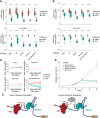A novel reporter for helicase activity in translation uncovers DDX3X interactions
- PMID: 38697667
- PMCID: PMC11251518
- DOI: 10.1261/rna.079837.123
A novel reporter for helicase activity in translation uncovers DDX3X interactions
Abstract
DDX3X regulates the translation of a subset of human transcripts containing complex 5' untranslated regions (5' UTRs). In this study, we developed the helicase activity reporter for translation (HART), which uses DDX3X-sensitive 5' UTRs to measure DDX3X-mediated translational activity in cells. To directly measure RNA structure in DDX3X-dependent mRNAs, we used SHAPE-MaP to determine the secondary structures present in DDX3X-sensitive 5' UTRs and then used HART to investigate how sequence alterations influence DDX3X sensitivity. Additionally, we identified residues 38-44 as potential mediators of DDX3X's interaction with the translational machinery. HART revealed that both DDX3X's association with the translational machinery and its helicase activity are required for its function in promoting the translation of DDX3X-sensitive 5' UTRs. These findings suggest DDX3X plays a crucial role in regulating translation through its interaction with the translational machinery during ribosome scanning and establish the HART reporter as a robust, lentivirally encoded, colorimetric measurement of DDX3X-dependent translation in cells.
Keywords: RNA helicases; RNA structure; reporter genes; translational control.
© 2024 Wilkins et al.; Published by Cold Spring Harbor Laboratory Press for the RNA Society.
Figures






Similar articles
-
Determinants of DDX3X sensitivity uncovered using a helicase activity in translation reporter.bioRxiv [Preprint]. 2023 Sep 14:2023.09.14.557805. doi: 10.1101/2023.09.14.557805. bioRxiv. 2023. PMID: 37745530 Free PMC article. Preprint.
-
Medulloblastoma-associated mutations in the DEAD-box RNA helicase DDX3X/DED1 cause specific defects in translation.J Biol Chem. 2021 Jan-Jun;296:100296. doi: 10.1016/j.jbc.2021.100296. Epub 2021 Jan 16. J Biol Chem. 2021. PMID: 33460649 Free PMC article.
-
eIF4B stimulates translation of long mRNAs with structured 5' UTRs and low closed-loop potential but weak dependence on eIF4G.Proc Natl Acad Sci U S A. 2016 Sep 20;113(38):10464-72. doi: 10.1073/pnas.1612398113. Epub 2016 Sep 6. Proc Natl Acad Sci U S A. 2016. PMID: 27601676 Free PMC article.
-
The human DEAD-box helicase DDX3X as a regulator of mRNA translation.Front Cell Dev Biol. 2022 Oct 25;10:1033684. doi: 10.3389/fcell.2022.1033684. eCollection 2022. Front Cell Dev Biol. 2022. PMID: 36393867 Free PMC article. Review.
-
The Role of the RNA Helicase DDX3X in Medulloblastoma Progression.Biomolecules. 2024 Jul 6;14(7):803. doi: 10.3390/biom14070803. Biomolecules. 2024. PMID: 39062517 Free PMC article. Review.
Cited by
-
DDX3X acts as a selective dual switch regulator of mRNA translation in acute ER stress.bioRxiv [Preprint]. 2025 Jun 9:2025.06.08.658532. doi: 10.1101/2025.06.08.658532. bioRxiv. 2025. PMID: 40661561 Free PMC article. Preprint.
-
Regulatory role of the N-terminal intrinsically disordered region of the DEAD-box RNA helicase DDX3X in selective RNA recognition.Nat Commun. 2025 Aug 28;16(1):7762. doi: 10.1038/s41467-025-62806-7. Nat Commun. 2025. PMID: 40877262 Free PMC article.
-
DEAD/DEAH-box RNA helicases shape the risk of neurodevelopmental disorders.Trends Genet. 2025 May;41(5):437-449. doi: 10.1016/j.tig.2024.12.006. Epub 2025 Jan 18. Trends Genet. 2025. PMID: 39828505 Review.
-
G3BP isoforms differentially affect stress granule assembly and gene expression during cellular stress.Mol Biol Cell. 2024 Nov 1;35(11):ar140. doi: 10.1091/mbc.E24-02-0062. Epub 2024 Oct 2. Mol Biol Cell. 2024. PMID: 39356796 Free PMC article.
-
Repurposing Biomolecules from Aerva javanica Against DDX3X in LAML: A Computer-Aided Therapeutic Approach.Int J Mol Sci. 2025 Jun 6;26(12):5445. doi: 10.3390/ijms26125445. Int J Mol Sci. 2025. PMID: 40564907 Free PMC article.
References
MeSH terms
Substances
Grants and funding
LinkOut - more resources
Full Text Sources
Research Materials
